Basic DR Robot Configuration
Basic DR Robot Configuration
The basic option requires a non-production, Eyeglass-specific SyncIQ policy to exist. The Runbook Robot will exercise the failover and failback of the data for this SyncIQ policy. This configuration does not fully exercise all automation required for failover, but it’s quick and easy to set up.
Prerequisites
- SyncIQ policy in any Access Zone BUT only “EyeglassRunbookRobot” prefixed policies will execute the failover logic.
- This type of Robot policy will not failover SmartConnect names, aliases, or SPNs.
- Ensure no SmartConnect Zones used by non-Robot policies will be failed over in the Access Zone.
- The Basic Robot is intended to operate on non-production data. The steps below include directions to create the Runbook Robot-specific SyncIQ policy on the cluster for the Basic Runbook Robot operation.
- Creating shares, exports, or quotas in the path of the Robot SyncIQ policy will result in these being failed over as well, utilizing the normal configuration sync jobs. This provides a method to test the entire configuration failover process. The configuration names for shares and exports can be any name.
info
Eyeglass will modify the description, Root Client, and Map Root User settings as required for Robot operation on an existing export with the same path as the Robot SyncIQ Policy root path.
- Quotas will be failed over during the Robot execution and deleted on the source automatically if quotas have been created within the SyncIQ policy used for the Robot.
- Eyeglass Hostname on the Network Card Setup and the Network Settings (setup using yast during the initial Eyeglass appliance configuration) must be identical.
Configuration Steps for Basic DR Robot
The steps are the following:
-
Log into the PowerScale OneFS Source cluster via OneFS.
-
Click on Data Protection, then SyncIQ, then on the Policies tab.
-
Click on + Create a SyncIQ Policy.
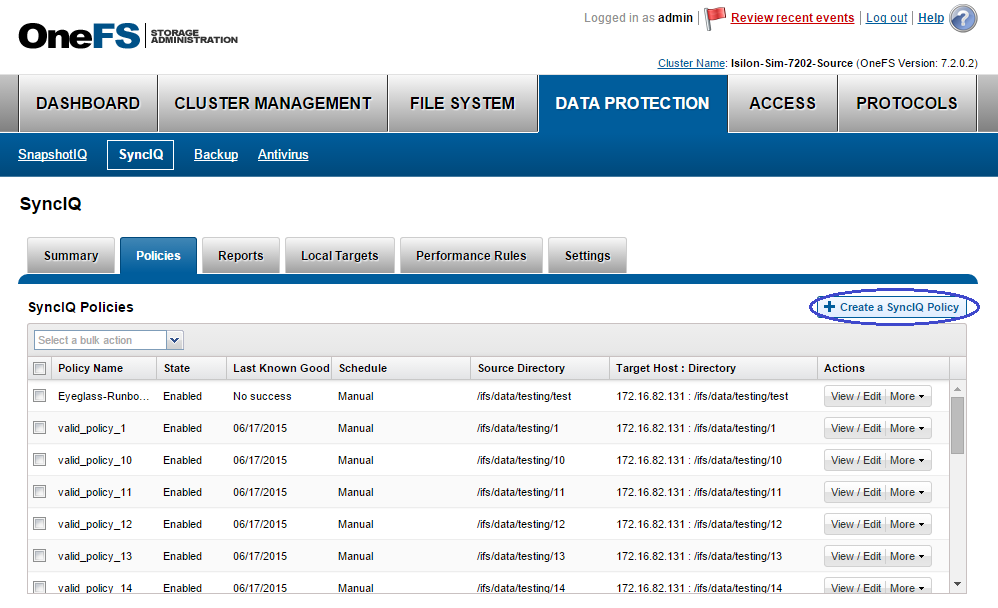
-
In the Settings section of the Create SyncIQ Policy window, enter
EyeglassRunbookRobot-XYZ(where XYZ is a random string) in the Policy Name field.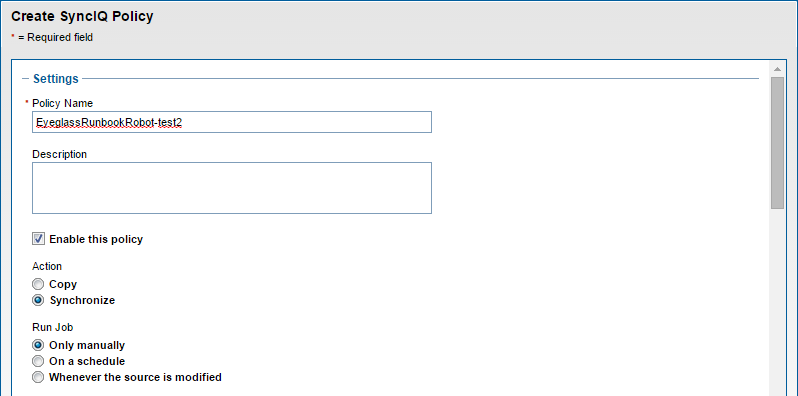 info
infoIMPORTANT: This name format must be followed exactly in order for the Basic Runbook Robot job to execute.
-
In the Source Cluster section, select a Source Root Directory by clicking Browse next to the box and navigating to the desired folder.
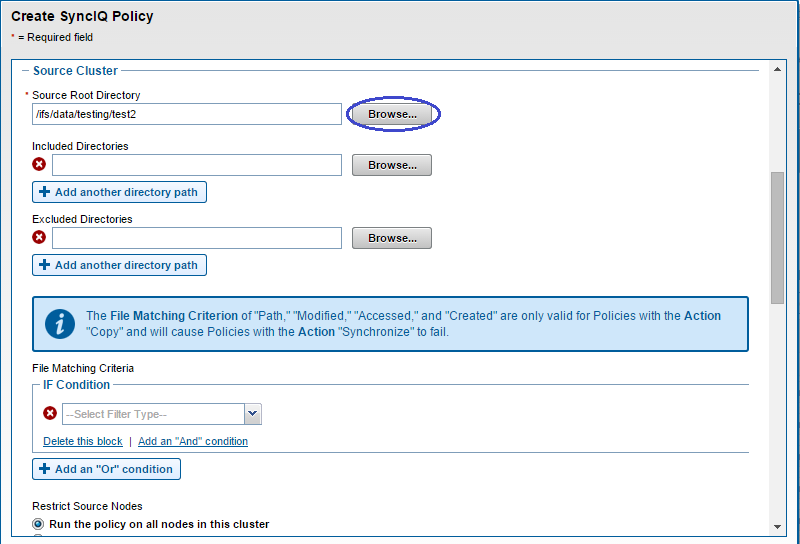 info
infoIMPORTANT: This should be a directory containing NON-production data as it will be failed over by default once a day.
-
In the Target Cluster section under Target Host, enter the target cluster SmartConnect zone name used for SyncIQ replication of the Target cluster, and under Target Directory, the path on the Target cluster to where the data will be replicated.

-
Do not enter or modify anything in the Target Snapshots and Advanced Settings sections.
-
Click on Create Policy. The policy will appear in the SyncIQ Policies chart.

-
Click on More and select Start Job on the newly created policy.
-
Ensure that the policy completes successfully.
-
Log into Eyeglass.
-
Open the Jobs window and select the Job Definitions section.
-
Under the Configuration Replication jobs, look for a Job Name that resembles
SourceClusterName_EyeglassRunbookRobot-XYZ(where XYZ is the random string chosen when creating the policy). Make sure its State is OK.info- This Job will be created after Eyeglass discovery has found the SyncIQ Policy created in the previous steps. If the Job is not present, wait for the next Eyeglass discovery cycle and then check again.
info- DFS mode can be enabled on the basic robot policy. Eyeglass will continue using NFS to write data to the cluster, but a DFS mount can be created to verify failover and failback operations over DFS by manually checking the DFS mount each day. Eyeglass will still perform normal NFS failover and failback data integrity checks.
How to Enable DFS Mode for Basic Robot
- Find the policy in the Configuration Replication section of the Jobs icon.
- Select the checkbox on the left-hand side for the Job mentioned above and click the Select a bulk action button at the bottom of the Jobs window. This time, click the Enable/Disable option.
- Select the checkbox on the left-hand side for the Job mentioned above and click the Select a bulk action button at the bottom of the Jobs window and click the Enable/Disable Microsoft DFS option.
infoThe inventory runs with every Eyeglass Replication cycle (every 5 minutes by default). It may be necessary to wait for the next Eyeglass Replication cycle for the new job to appear in the jobs window.
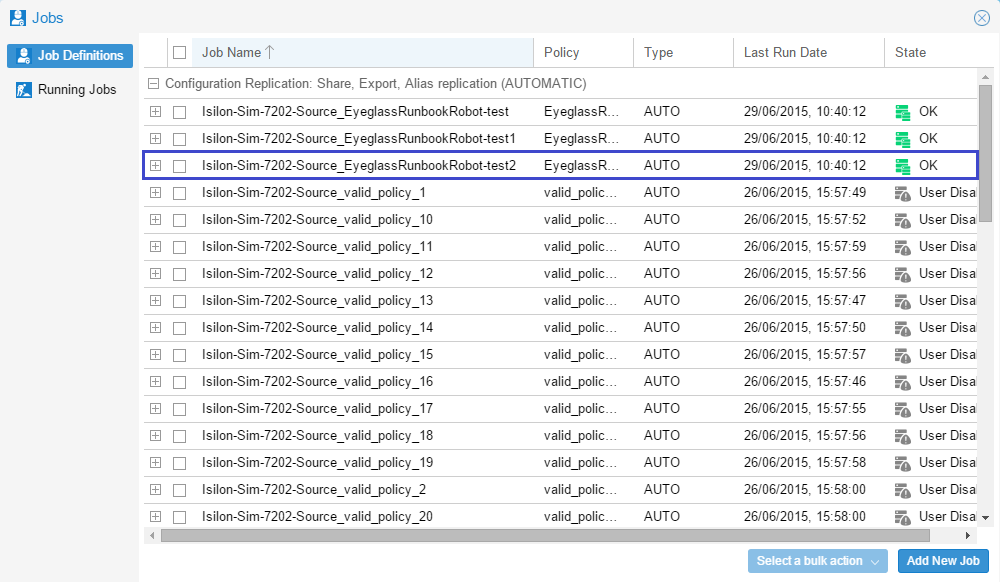
-
If the SyncIQ Policy Name that was created has been entered properly, a new type of Job category will appear in Eyeglass: Failover: Runbook Robot (AUTOMATIC).
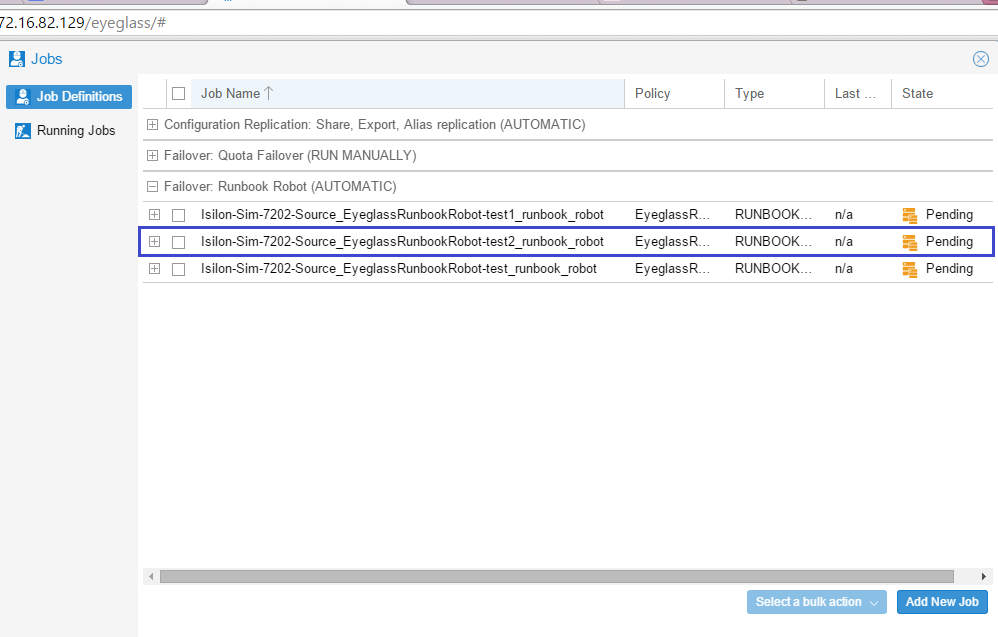
-
By default, the Job will be queued to run at midnight every day.
-
To test the policy after creation, select the job in the Jobs window and use Bulk Action to run it immediately.
-
When the Runbook Robot Job runs, in the Running Jobs section a job will appear with the Name Runbook Robot, followed by a timestamp.
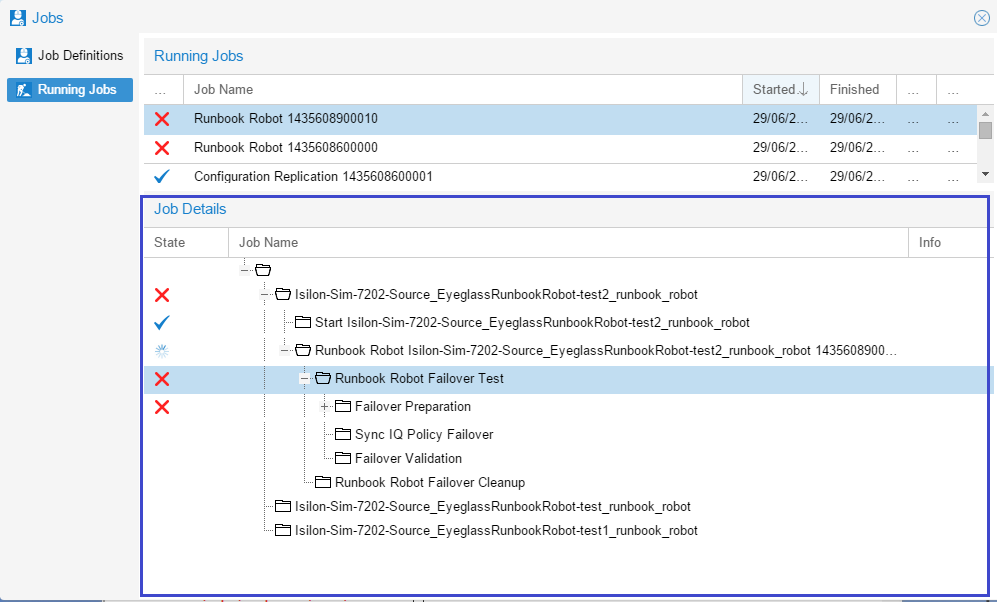
-
The Runbook Robot job will run a three-stage Failover Test, which consists of a Failover Preparation, SyncIQ Policy Failover, and Failover Validation. Once this is done, it will run a Failover Cleanup.
-
The Failover Preparation component consists of the following steps:
- The job will create a new Eyeglass export or update an existing Eyeglass export with the following parameters:
- Description: Superna Eyeglass Runbook Robot export Appliance ID
- Root Clients: The Eyeglass IP address used
- Map Root User settings
- Directory Paths: The Source Root Directory chosen when creating the SyncIQ Policy
- This export is then mounted on the Eyeglass appliance.
- Data is then written to the export, which is dependent on the SyncIQ Policy Path and timestamp.
- The job will create a new Eyeglass export or update an existing Eyeglass export with the following parameters:
-
To view the exports created: open PowerScale OneFS with the IP address of the source cluster, click on the Protocols tab, then click on UNIX Sharing (NFS), followed by the NFS Exports tab.
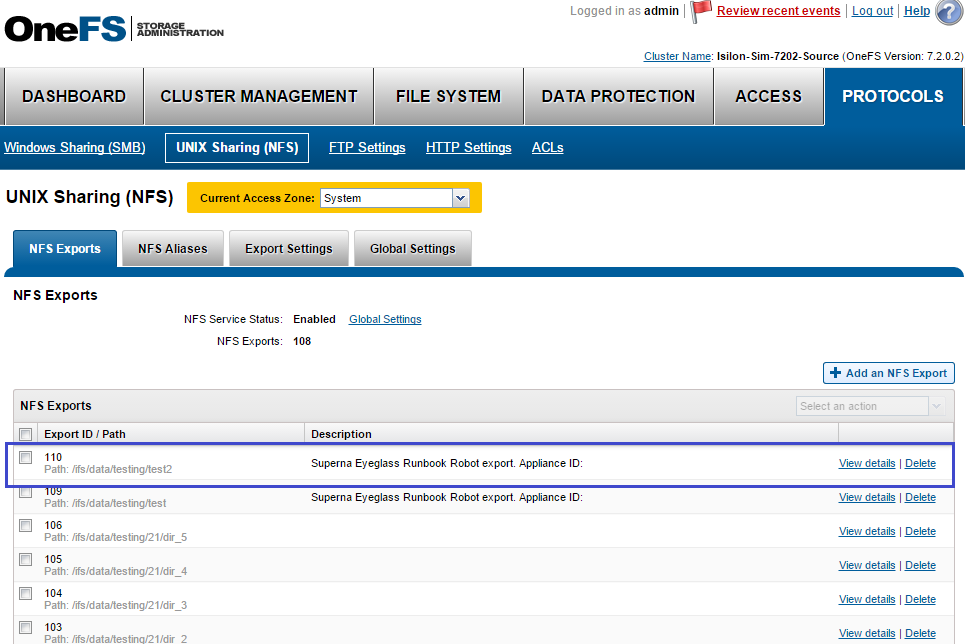
-
Once the preparation is successfully completed, Eyeglass performs a SyncIQ Policy Failover.
-
On completion of the failover, Runbook Robot will run a Failover Validation to ensure the data was failed over without issues. The Failover Validation component consists of the following steps:
- The export created is mounted on the Eyeglass appliance using the IP address of the failover target cluster.
- The timestamp is read to confirm it is identical to what was written during the Failover Preparation step.
- A new timestamp is written to the Failover.ts file.
- This new timestamp is then read to confirm it has been written correctly.
- If enabled (enabled by default), this export is then mounted from the Eyeglass appliance. For more details, check 'Default Runbook Mode: SMB' in the How to Use Runbook Robot guide.
-
Once the Failover Test has been completed, the Runbook Robot job will run a Failover Cleanup, which consists of unmounting the export from the Eyeglass appliance.
-
The default Robot jobs run every day at midnight and execute a failover Robot policy:
- Creates export.
- Mounts the cluster writes test data using the export created.
- Runs the policy.
- The policy is failed over.
- Mounts the data on synced export on target.
- Unmounts.
- Moves the schedule on policy to the target.
- Runs resync prep on source.
- Goes to sleep until time to failback.
-
Methods to verify it was successful:
- Check the DR Dashboard policies tab and verify it’s green.

- Check the cluster SyncIQ policy status on both clusters and make sure the policy moves from one cluster to the other each day.
- Make sure the test file exists with a current date and time stamp on the active cluster (Hint: look in the policy path root file system for the test file).
- If a quota was applied to Robot policy path, make sure the quota moved to the target cluster AND was deleted on the source cluster (Eyeglass moves policies on failover).
- Review the Failover Log (DR Assistant / Failover History / Open log file). Failover log may also be downloaded from the Failover Log Viewer using the Download File link.
- Check the DR Dashboard policies tab and verify it’s green.
See Also
-
Advanced DR Config: Learn how to configure advanced disaster recovery settings, including changing the Robot scheduled interval, creating manual NFS exports for Runbook Robot, and setting up multiple Robot features across various replication topologies.
-
Advanced Settings: Detailed instructions on advanced disaster recovery configurations, such as manually creating NFS exports for Runbook Robot, setting up multi-site replication topologies, and pool mapping hints for a robust failover strategy.